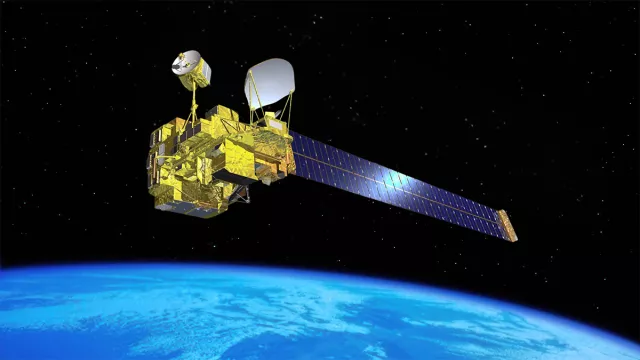The POLDER instrument (POLarization and Directionality of the Earth’s Reflectances) conceived by CNES was designed to study the properties of clouds and aerosols, and their major impacts on climate, by analysing the light reflected from Earth and its atmosphere.
Key information
| Mission | Study Earth’s atmosphere and analyse the characteristics of light reflected from the Earth-atmosphere system |
|---|---|
| Domain | Earth observation |
| Launch date | First launch 17 August 1996 |
| Partners | CNRS |
| Where | On ADEOS, ADEOS-2 and Parasol |
| Lifetime | 10 months (ADEOS), 9 months (ADEOS-2), 8 years (Parasol) |
| Status | Completed |
Key figures
- 3 POLDER instruments flown
- 443 nm, 670 nm, 865 nm: imaging wavelengths
- 30 kg: instrument mass
- 14 repeat observations of a point on Earth over a single orbit
Key milestones
- 18 December 2013: End of POLDER-3 mission on Parasol
- 18 December 2004: Launch of POLDER-3 on Parasol satellite by Ariane 5G+
- 23 October 2003: End of POLDER-2 mission on ADEOS-2
- 14 December 2002: Launch of POLDER-2 on ADEOS-2 by H-IIA
- 30 June 1997: End of POLDER-1 mission on ADEOS-1
- 17 August 1996: Launch of POLDER-1 on ADEOS-1 by H-II
Project in brief
Developed by CNES in collaboration with the LOA atmospheric optics laboratory in Lille, the POLDER instrument was designed to study clouds and aerosols, which are known to play a key role in the climate system. POLDER analysed the intensity and direction of light reflected by the Earth and its atmosphere, as well as its polarization, a physical characteristic describing how waves propagate. Such measurements reveal the properties of clouds and aerosols, thereby telling us more about how they affect climate.
There have been three successive generations of instruments: POLDER 1, 2 and 3. POLDER 1 and POLDER 2 were launched on the Japanese ADEOS and ADEOS 2 satellites on 17 August 1996 and 14 December 2002. Unfortunately, both satellites encountered serious technical hitches that brought their mission to a premature end. With POLDER 3 on the other hand, which departed Earth on 18 December 2004 on the French Parasol microsatellite, CNES teams were able to exploit the instrument’s full potential. The Parasol mission continued to operate up to the end of 2013, exceeding its planned design life by more than five years.
CNES’s role
The POLDER instrument was developed by CNES in partnership with the LOA atmospheric optics laboratory in Lille.
Contacts
Atmospheric Physics & Meteorology subject matter expert
Adrien Deschamps
E-mail: adrien.deschamps at cnes.fr


